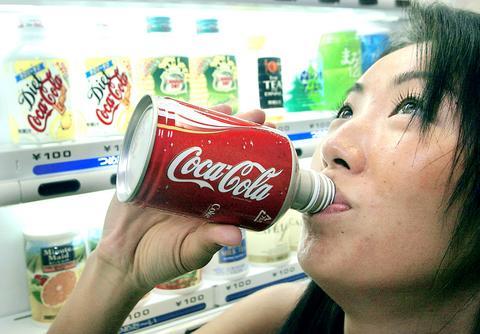There hasn't been much change in the world of beverage cans since the stay-on tab replaced the ring-pull tab in the late 1980s. But now Japan has put a new twist on the old can, and it's coming your way.
The "bottle can," an aluminum can with a screw cap, has taken Japan by storm, as consumers show a growing thirst for its novelty value and the ability to re-close it like a bottle.
Now the can is set to take on international markets.

PHOTO: REUTERS
"Many customers in the US are interested in this new form of packaging, and in Europe too several companies are keen," Yoshiaki Adachi, head of research at privately owned Daiwa Can Company, Japan's largest can maker, said.
Since Daiwa Can launched the new can in late 1999, Japanese bottle can sales have jumped to 1.7 billion from last year, from 240 million in 2000 and are set to grow to two billion this year.
Drink makers in the US and Europe are vying to get their hands on the new technology, and Daiwa Can is now selling the cans to Kraft Foods Inc, which is using them for its "Capri Sun" children's fruit drink in the US.
"The new Capri Sun Island Refreshers line is the first in the US to launch a juice drink in a revolutionary aluminum `bottle can,'" Kraft, the largest US food maker, said on its Web site.
If Daiwa Can can, more will follow.
Adachi said his firm is in talks with other potential US customers, adding that negotiations were under way with Ball Corporation, one of the largest US metal can manufacturers, about producing the bottle-cans in the US.
"There is no doubt that screw-top cans will take off outside Japan, both in the US and Europe, though so far can makers there have not had the confidence to invest in them," said John Nutting, editor-in-chief of London-based The Canmaker magazine.
He said the new cans could boost a global market of 235 billion cans a year, partly because re-sealable cans could reclaim shelf space in motorway service areas. "Regular cans are not re-closable, so drivers do not buy them," Nutting said.
The cans, which come in a range of sizes up to 500ml, are a hit in Japan, and not only with drivers.
"They're so much better than regular cans. You can take a sip, close them, and put them in your bag," said Mamta Reid, a language teacher in Tokyo.
Others just buy them for the look.
"If I have a choice of buying a Coke in a plastic bottle or a screw-cap can, I buy the can. It looks good, it's space-age packaging," said Gavin Skinstad, a Tokyo-based banker.
Industry watchers question whether consumers outside Japan will be willing to pay more for a bottle-can that costs about twice as much as an ordinary aluminum can.
"Elsewhere in the world, people less easily accept having to pay more for attractive packaging," Nutting said.
Smaller bottle cans, up to 300ml, look like a regular can with a conical top and a screw-cap, but the bigger sizes look more like an aluminum bottle.
Can makers tout their technical advantages.
"These cans are better than plastic bottles at shutting out sunlight and oxygen," said Toru Komano, a spokesman for Mitsubishi Materials, Japan's third-largest can-maker, which started making bottle cans in 2002.
The aluminum bottle cans are also lighter than plastic bottles and easier to recycle, producers said.
Last year, about 8 percent of the estimated 18 billion cans sold in Japan had a screw cap, and that number is set to grow to 14 percent this year, Komano said.
The new cans were first used by Japanese beverage makers such as Kirin Brewery Co Ltd, but a big breakthrough came in June ;last year, when Coca-Cola (Japan) Company started selling Coke, Fanta and Sprite in 275ml bottle cans through its ubiquitous vending machines.
For now, Coca-Cola Co does not use the cans in other countries, a Coca-Cola Japan spokeswoman said.
Japanese can makers expect the bottle can will help their industry win back market share from plastic bottles.
The use of plastic bottles (called "PET" bottles, after the kind of plastic they are made from) in Japan has soared since 1996, when bottle producers dropped an environment-friendly gentleman's agreement not to produce small bottles.
From just 2.2 billion in 1997, consumption of PET bottles rose to 8.8 billion last year, mainly at the expense of steel cans, whose numbers crumpled to 16.1 billion per year from 21.5 billion, according to Mitsubishi Materials.
Over the same period, aluminum cans held their ground with sales stable at about 18 billion cans per year, but the fizz was out of the market.
"The plastic bottle makers started invading our market. We developed the bottle can to restore market share for metal packaging," Daiwa Can's Adachi said.

It’s always a pleasure to see something one has long advocated slowly become reality. The late August visit of a delegation to the Philippines led by Deputy Minister of Agriculture Huang Chao-ching (黃昭欽), Chair of Chinese International Economic Cooperation Association Joseph Lyu (呂桔誠) and US-Taiwan Business Council vice president, Lotta Danielsson, was yet another example of how the two nations are drawing closer together. The security threat from the People’s Republic of China (PRC), along with their complementary economies, is finally fostering growth in ties. Interestingly, officials from both sides often refer to a shared Austronesian heritage when arguing for

Nov.10 to Nov.16 As he moved a large stone that had fallen from a truck near his field, 65-year-old Lin Yuan (林淵) felt a sudden urge. He fetched his tools and began to carve. The recently retired farmer had been feeling restless after a lifetime of hard labor in Yuchi Township (魚池), Nantou County. His first piece, Stone Fairy Maiden (石仙姑), completed in 1977, was reportedly a representation of his late wife. This version of how Lin began his late-life art career is recorded in Nantou County historian Teng Hsiang-yang’s (鄧相揚) 2009 biography of him. His expressive work eventually caught the attention

Late last month the Executive Yuan approved a proposal from the Ministry of Labor to allow the hospitality industry to recruit mid-level migrant workers. The industry, surveys said, was short 6,600 laborers. In reality, it is already heavily using illegal foreign workers — foreign wives of foreign residents who cannot work, runaways and illegally moonlighting factory workers. The proposal thus merely legalizes what already exists. The government could generate a similar legal labor supply simply by legalizing moonlighting and permitting spouses of legal residents to work legally on their current visa. But after 30 years of advocating for that reform,

The Nuremberg trials have inspired filmmakers before, from Stanley Kramer’s 1961 drama to the 2000 television miniseries with Alec Baldwin and Brian Cox. But for the latest take, Nuremberg, writer-director James Vanderbilt focuses on a lesser-known figure: The US Army psychiatrist Douglas Kelley, who after the war was assigned to supervise and evaluate captured Nazi leaders to ensure they were fit for trial (and also keep them alive). But his is a name that had been largely forgotten: He wasn’t even a character in the miniseries. Kelley, portrayed in the film by Rami Malek, was an ambitious sort who saw in